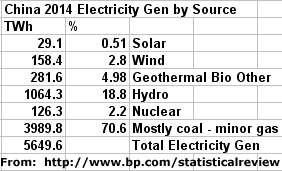We all know that the world crude oil price crashed starting mid 2014 – from levels around $100 per barrel it is now ~$35. Obviously fracking in the USA has boosted oil production but an additional reason for the price crash is the Saudis economic warfare to minimise the power of Iran post sanctions. I posted on that subject about a year ago. Saudis oil pumping crashes oil price kneecapping the Iranian economy – how do the Teheran Mullahs pay to build those nukes now? Anyway – back to the subject today. The ABC reports – Peak oil losing credibility as renewables shift accelerates and Fairfax chimes in – The price drop that’s really worrying big oil –
To put renewables on scale with global oil consumption I have made this chart using data from the BP Statistical Review of World Energy – get the XLS file and explore for yourself. Oil consumption has been converted to Terrawatt Hours to compare with solar and wind global electricity generation. It is crystal clear that the microscopic quotas of heavily subsidised renewables in the bottom right corner of my chart could not possibly be having any serious influence on the massive global consumption of oil.

If you want to add global coal consumption on for 2014 that is another 17,000TWh equivalent and global electricity consumption all sources in 2014 totals 23,536TWh. I wonder where this Green/Renewables fantasia originated.
Correct, Saudi economic warfare is the prime reason for the current low oil price, only delusional green/left, tea leaf reading could come up with the idea that renewables will ever be truly price competitive in a real world economy.
In spite of the huge subsidies currently paid in support of renewables and the mandated artificial market distortions working against fossil fuels, according to the BP Review, in 2014 renewables (excluding hydro) produced only 2.8% of the primary energy that fossil fuels (oil, gas and coal) did. It’s obvious to anyone with an ounce of savvy that if it weren’t for the mandated subsidies and market distortions there would be no “renewables industry”.
Hydro-electric power could have an effect on oil prices but it is not, as the Greens oppose it along with Nuclear Power. ‘Renewables’ have no effect on oil prices as they are ineffective, subsidised, expensive and intermittent, needing coal-gas-oil back-up. Unicorn power has as much effect on oil prices as ‘renewables’.
Nicholas, The greens have no say in China and Russia. Expect to see a lot more Hydro in China. A major reason for China claiming Tibet is the potential of hydro and exploiting the minerals there. The 3 gorges dam on the Yangtze with 22,000 MW of power (with 6 turbine/ generators of 600-660 MW imported and 26 x 700MW Chinese made) is an example of Chinese technology. I may be wrong but I read somewhere the Chinese are looking at 20-25% of their power coming from Hydro, 20% Nuclear and 50% coal by 2030. The Russians are building defences in the arctic circle to protect their claimed potential oil and gas reserves but it will not be long before they will consider hydro potential in the Urals and Siberia.
@ cementafriend
> … the Chinese are looking at 20-25% of their power coming from Hydro, 20% Nuclear and 50% coal by 2030
That is what my Chinese engineer colleagues tell me as well
They certainly have the skills and confidence to do this. Much more so than that observed in Aus over the last 10 years
This table shows China electricity generation mix for 2014 – note nuclear is less than wind – would take a colossal effort to get nuclear to 20% by 2030

After being in decline for decades nuclear energy may be about to become a significant player in electricity generation once again, particularly in China. Free from the need to placate an irrational green lobby the Chinese it seems are making real efforts to develop a commercially viable Thorium reactor. Whether this is because they have genuine concerns about GHG emissions or whether it’s because they have other plans for their coal deposits such as coal to liquids conversion perhaps, who knows?
Warwick, I suggest that some of the BP figures are wishful thinking. I understand that there is no Solar generation connected to the grid. They may have a few solar farms for checking the life and collection efficiency of panels but nothing goes to the grid. Also, there are no solar domestic panels – I did not see any during a trip through China. There certainly were no solar panels to be seen in Chongqing (33 million living in mainly high rise apartments). I also suggest the wind generation is fiction. Maybe there are some out in the sparsely populated desert regions (with coal and diesel backup working most of the time) but none in the populated eastern and southern areas. I do not believe there is any geothermal generation -it is mainly oil and gas. Some cement plants generate electricity by steam from waste heat boilers (Japanese technology which I have seen). Pulp & Paper plants can co-generate using wood waste and lignin.
I also suggest the the Nuclear plants are underestimated. China does not display its nuclear capability. You may get the correct order if you add the wind to the nuclear.
From cementafriend:
> Maybe there are some [solar panels, windmills] out in the sparsely populated desert regions (with coal and diesel backup working most of the time)
I saw none at all, and I’ve done projects west through China past Urumqui almost to the Kazakh border (I should add that winter there, Gobi and Makan Deserts, is not really conducive to relying on solar or wind)